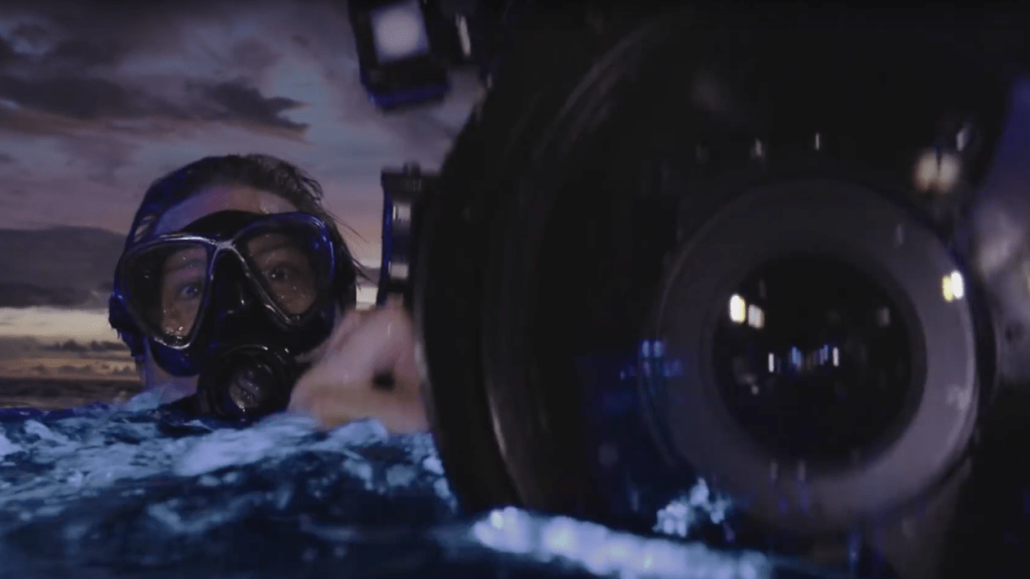How a Canon campaign used image recognition to shatter industry benchmarks

In early 2017, Canon was looking to support “Canon See Impossible,” a brand positioning designed to promote its diverse array of digital imaging products. Appropriately enough, Canon’s first goal was to reach a wider audience with its new video content.
That’s when the company enlisted computer vision specialist GumGum through its media partner, GroupM’s MediaCom. “Canon wanted to drive engagement and utilize our high impact mobile units,” said Ben Plomion, CMO at GumGum.
—
Seeing the light
Canon created two sets of creative for the campaign. One set, dubbed “See Beyond Darkness,” was anchored by a short documentary video shot in the Solomon Islands. In it, scuba-diving researchers plunge into the ocean depths in the dead of night. First they explore a remote coral reef, before trailing behind a biofluorescent turtle — a newly discovered species that had never been seen on video.
Despite the use of minimal light, the videographers capture the turtle’s natural environment in vivid detail. That’s the point, of course: It’s shot with Canon cameras.
The other set of ads, cumulatively referred to as “See the Light,” followed a similar theme. The video at the center of this approach was titled “See Beyond Darkness.” Ranging from the ocean floor to the reaches of outer space, the video showcases Canon’s imaging technology — particularly its ability to help capture video in low-light conditions.
Both sets of creative were painstakingly produced. (Just take a look at the making-of video for “See Beyond Darkness.”) But such levels of care and investment are only worth it if those messages reach the right audiences.
Having the vision
Here’s where GumGum, the computer vision specialist, entered the picture.
What is computer vision exactly? Basically, it’s an umbrella term describing any technology that allows a computer to analyze and understand images and videos. A self-driving car that can see the road better than the human in the passenger seat? It’s using computer vision. That Google app that lets you match yourself to a 14th century Renaissance portrait? That too. The list of applications is growing by the day.
GumGum uses computer vision to power contextual targeting. By searching the web for images, videos and keywords, its technology can automatically place ads next to relevant content. So if a brand is selling cameras, GumGum might place ads next to visual content that’s related to cameras and photography, or even next to specific content related to the brand in question.
That’s exactly what it did for “See the Light” and “See Beyond Darkness.” Display ads, videos and video links, all laser-targeted at specific demographics, ran across premium sites like Men’s Journal and Fortune. More importantly, the ads were placed alongside contextually relevant content within those sites. “We surrounded images of cameras and camera lenses, of office buildings,” said Plomion. “We bundled that all together, using our first party data and the data Canon provided us with.”
GumGum also found prime real estate next to Canon products — perfect for customers who were already interested in the brand. “GumGum’s brand logo recognition technology let us deliver Canon messaging wherever a Canon product was featured in text, imagery or video,” explained Fernando Cadena, partner and communications planning director at MediaCom.
Plus, GumGum rolled out a new ad product for the campaign, which the company referred to as a mobile frame unit. Canon was one of the first brands to take advantage of it, allowing them to capture and own the content in an innovative way. “When the user loads the page, the outside of the unit animates for about 3 seconds and then collapses a banner on the bottom as the user scrolls,” Plomion explained.
A sweeping view
Seventy-five percent of the placements ran on mobile platforms, with the other 25 percent on desktop. “Consumers aged 25-44 had higher recall and were more favorable and likely to purchase than older consumers,” said Cadena. “Given that millennials consume a lot more mobile content, the results are logical.”
Throughout the campaign, GumGum guaranteed 100 percent viewability for all placements. “GumGum’s ability to deliver full visibility without [any] messaging or logo cut-off creates a better experience for the viewer and, ultimately, higher brand recognition and favorability,” Cadena said.
A look back
The metrics told a sunny story. Click-through for the campaign wound up at more than 2.5 percent — close to 22 times higher than the average industry benchmark of .12 percent. Meanwhile, the campaign’s engagement rate sat at nearly 7 percent, significantly better than the average benchmark of 2.8 percent. Finally, the campaign’s video completion rate wound up at more than 69 percent, higher than the standard industry benchmark of 61.5 percent.
Bottom line: People saw the ads, watched the videos and were altogether engaged — much more so than one might expect for a campaign of similar scope and budget.
“We wanted to deliver an engaging and meaningful experience using Canon technology and then make sure everyone viewed the video,” said Chris Sedlacek, sr. director/general manager of corporate communications at Canon. “Our shoot in the Solomon Islands certainly achieved the first objective.”
But it was GumGum, Sedlacek said, that helped Canon achieve the second objective. “They offered a platform for our messaging to reach a broad audience.”
More from Digiday

What does the Omnicom-IPG deal mean for marketing pitches and reviews?
Pitch consultants predict how the potential holdco acquisition could impact media and creative reviews heading into the new year.

AdTechChat organizers manage grievances amid fallout of controversial Xmas party
Community organizers voice regret over divisive entertainment act at London-hosted industry party, which tops a list of grievances.

X tries to win back advertisers with self-reported video stats
Is X’s big bet on video real growth or just a number’s game?





